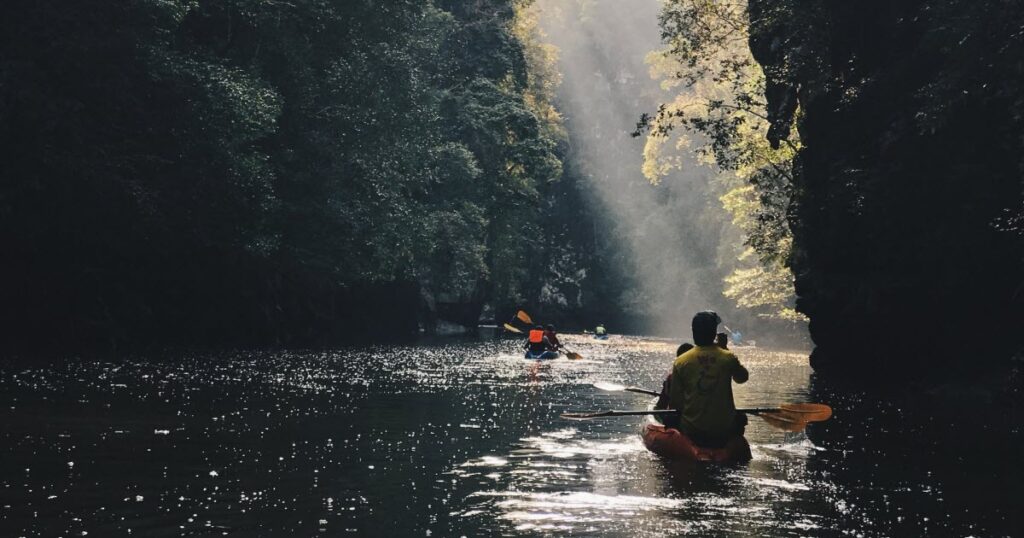There’s a very good reason I’ve been kayaking for years. This exciting activity gets my heart pumping when I want it to, and calms me when I need it to. Kayaking also provides memorable moments in the great outdoors. It’s an excellent workout, especially for my torso, core, arms, and legs. But more than that – I find it to be a renewing, almost spiritual activity … especially when I am kayaking on rivers?
If you’d like to learn more about the different kinds of kayaking and what you need to do to get started? Read on to find out what I love about river kayaking, and why it might be the perfect activity for you.
Forms of River Kayaking
River kayaking is an activity that almost anyone can enjoy. You just have to find the right type of river kayaking for you.
Here we’ll discover the different forms of river kayaking. These include:
- Recreational kayaking
- Touring kayaking
- Whitewater kayaking
- Kayak fishing (or angling)
We’ll also find out about types of kayaks suitable for different settings and circumstances. Let’s go!
Recreational Kayaking
Recreational kayaking is the most basic form of river kayaking, but that doesn’t make it any less fun! It’s perfect for having fun on the water while exploring nature at your own pace.
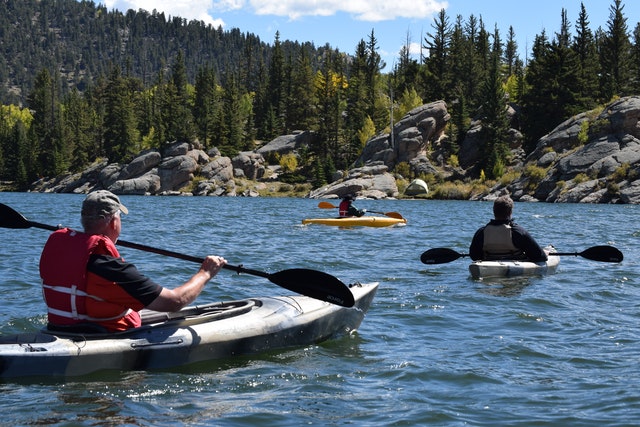
In addition to rivers, you can see this type of kayaking on well-protected lakes, ponds, or in local parks and resorts. Typically, recreational kayaking is ideal for beginner paddlers.
Recreational kayaking is even suitable for kids, making it great for the whole family.
Kayaks designed for recreational kayaking are often wide and about 9 to 12 inches long. Wide kayaks offer better stability and control on the water.
Recreational kayaks are also lightweight. Typically, they’re made of materials like:
- Polyethylene
- ABS plastic
- Carbon fiber
- Fiberglass
A sit-on-top kayak is ideal for beginners because you can get in and out of it with ease. They also give your knees more space, which can be an issue with sit-in kayaks.
Sit-in kayaks keep you dry because they have a cockpit and hatch. They also have more storage space, so you can bring items with you on your adventure.
Touring Kayaking
Touring is another recreational kayaking you can do on protected bodies of water. But unlike recreational kayaking, touring kayaking involves a long journey.
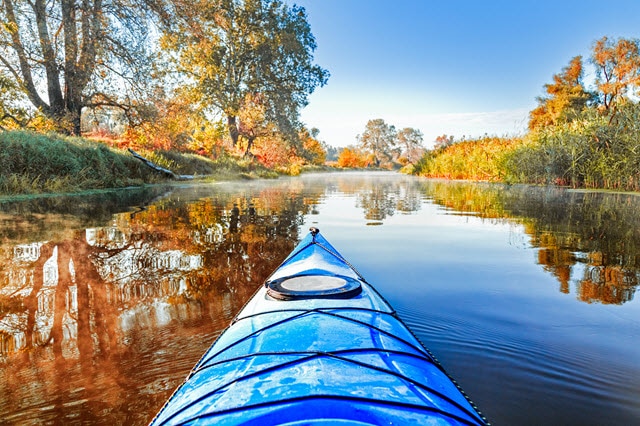
While you can go kayak touring as a beginner, it’s better to wait until you’ve had some experience. If you’re determined to go earlier on, make sure you have a guide or experienced paddler with you.
You will be covering a lot of distance, and the paddling environment can be unpredictable.
Touring kayaks are longer and narrower than recreational kayaks. That’s because they’re built for speed and covering a longer distance.
The usual length for touring kayaks is about 12 feet long. Sit-in kayaks are a popular choice for touring paddlers.
They provide plenty of storage space for extra gear and supplies.
Whitewater Kayaking
Whitewater kayaking is only for advanced kayakers. It’s extremely exciting but tends to be dangerous. It involves kayaking on intense rapids instead of calm and flat water.
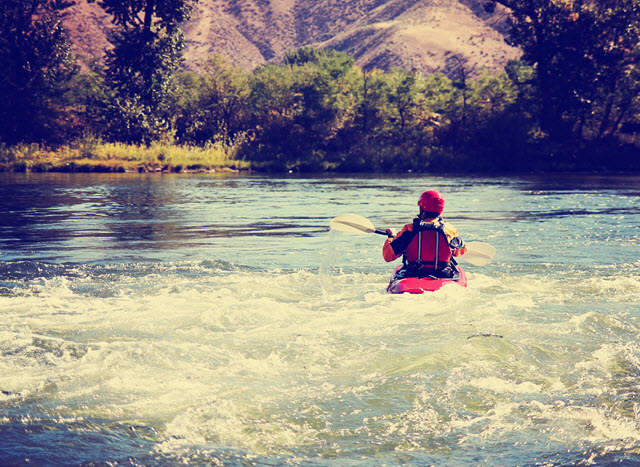
You need to learn different paddling techniques to successfully maneuver through whitewater or rough water. Rapids vary according to difficulty level.
If you’re up for a challenge, you can even kayak down steep drops and waterfalls on the river, or through obstacles such as rock gardens.
There are four different types of whitewater kayaks. The types of kayak you choose depend on the level of difficulty of the rapids you wish to take on.
Playboats
Playboats are ideal for taking on standing waves and holes in the rapids.
River Runner
The river runner is a great option if you’re following a fast-moving river course. It lets you navigate holes and drops.
Creek Boats
Creek boats provide better maneuverability when navigating tight and winding courses.
Long Boats
Long boats have a long and narrow shape, as well as a storage area. They’re great if you’re going on a fast river run on gentle rapids.
Kayak Fishing (or Angling)
Are you an angler?
The right kayak can be more affordable than using a large motorboat. It’s often more nimble and maneuverable, too.
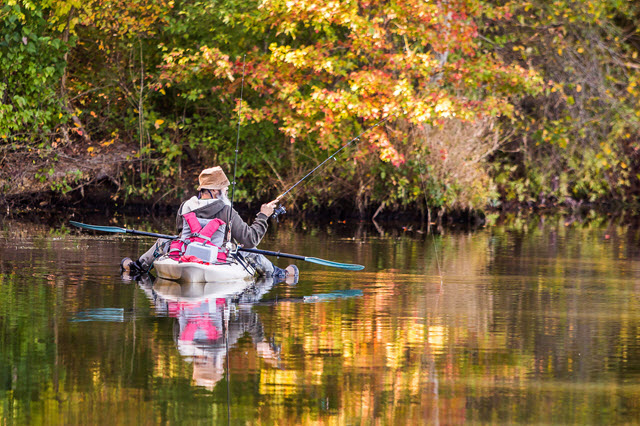
In fact, some fishing grounds can only be accessed by kayak.
Sit-on-top, sit-in, and inflatable kayaks are popular choices for kayak fishing.
- Sit-on-top kayaks are stable, allowing you to stand up in them when you’re casting or reeling in a catch.
- Sit-in kayaks keep the water off your boat and protect you from colder weather conditions.
- Inflatable kayaks are lightweight, portable, and are an ideal option if you have limited storage space.
Some fishing kayaks are pedal-powered. These cost more than traditional paddle kayaks.
Pedals let you paddle with your feet to free your hands to hold your fishing rod and manage your watercraft.
My River Kayaking Tips
Whether you’re kayaking on rivers for the first time or have done it before and are preparing for a more challenging experience, there are a few things to keep in mind before you set out on your next expedition.
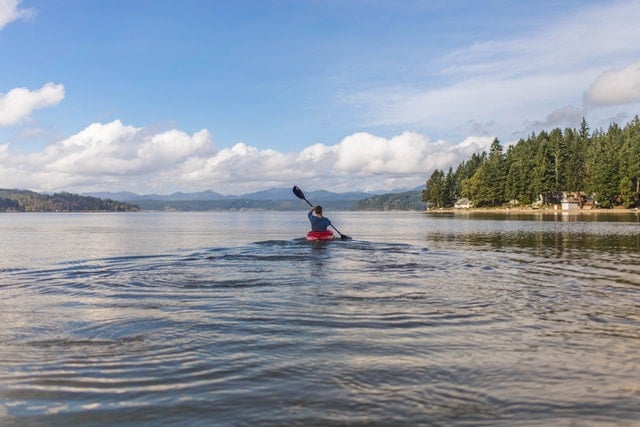
Attend a Paddling Class
Set aside time to take basic paddling lessons, or perhaps a refresher course if it’s been a while since you last went kayaking. Classes with certified instructors teach you essential techniques such as:
- Entering and exiting a kayak
- Paddling
- Maneuvering
- Recovering when the boat capsizes
Classes also offer a safe place for you to practice what you’ve learned. That way you can learn basic skills before going out kayaking on rivers.
Instructors will also provide information on which kayak gear and equipment to purchase.
Choose the Proper Kayak and Paddle
There is a wide range of kayaks and paddles on the market. Selecting the right equipment plays a key role in your comfort, safety, and enjoyment.
Don’t rush out to buy a kayak and paddle if you’re not sure yet which ones are best for you. Take your time making this decision.
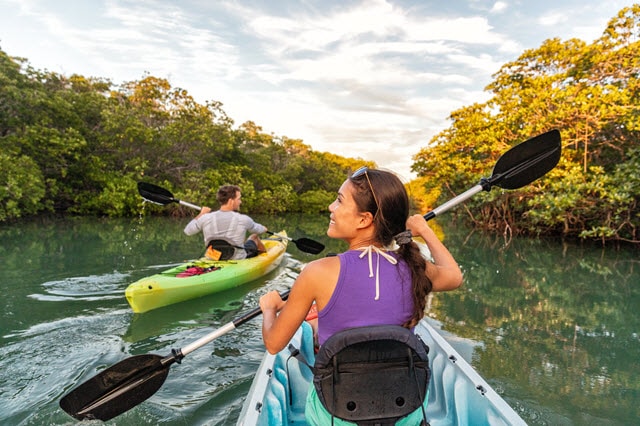
Try borrowing or renting different kayaks and paddles first, as you learn the basic techniques. This will give you the chance to try different kinds of equipment, helping you make a more informed decision when making a purchase.
Once you’ve gained enough kayaking experience, you can decide which equipment suits your preferences.
If you’re a beginner choosing between a sit-in vs a sit-on-top kayak, you might want to opt for a sit-on-top kayak. These are wider and more stable than a sit-in kayak.
Ideally, the size of the kayak should complement your weight and height. This will make it easier to control and keep upright on the water.
Choose a lightweight paddle that is the proper length for you. You shouldn’t have any difficulty lifting it repetitively as you thread through the water.
Ask for advice from an experienced paddler or a qualified instructor if you’re having trouble choosing the proper equipment.
Practice, Practice, Practice
Practicing basic techniques such as proper posture, paddle grip, and paddling strokes will improve muscle memory and build confidence. Start practicing on land.
Once you feel you have a good grasp of the techniques, you can move from land to shallow, calm waters. Keep on practicing until you feel comfortable with your paddling skills.
Even better, keep going until it feels like second nature.
Learn These Basic Kayak Strokes
There are 4 basic kayaking strokes to learn before you head out on the water:
- Forward stroke
- Reverse stroke
- Sweep stroke
- Draw stroke
Let’s learn about these strokes below.
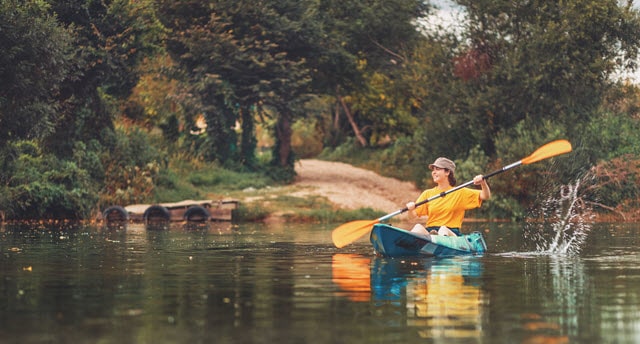
Forward Stroke
In the forward stroke, you keep your body upright and grip the paddle with your hands about shoulder-width apart. Dip the blade and slice the water counter-clockwise, keeping your elbow close to your body.
This stroke requires a lot of arm power and involves your core and back muscles.
Reverse Stroke
You use the reverse stroke to slow down a fast-moving kayak, or to move your kayak backward. It’s basically the forward stroke but done in reverse motion.
Dip the blade into the water at the side of your hip, then push it forward and slowly out of the water.
Sweep Stroke
The sweep stroke is useful when you need to make a turn or adjust the direction of the kayak. You need to extend your arm forward and immerse the paddle blade in the water near your feet.
Draw Stroke
The draw stroke is a useful paddling technique if you need to move your kayak sideways without turning. Perform this stroke by rotating the paddle blade while it’s in a horizontal position and the tip of the blade is touching the water.
Then, pull the blade towards your body, with the tip still in the water. You may need to do this several times to reach where you want to go.
Once you’ve learned these paddling strokes, you’re ready to efficiently maneuver your kayak!
Study and Identify the Local Hazards
Each area has its hazards. It’s crucial to do some research on the places you want to go and be familiar with the routes you will paddle.

Rivers and other bodies of water may have dangerous obstacles while kayaking. These obstacles include:
- Sweepers or trees and debris that jut out of the water
- Strainers or underwater trees that may be difficult to see from above
Also, if you’re kayaking in rivers that lead to salt marshes and the ocean, check out the tides and weather conditions before you set out on the river in your kayak. Prepare items that will help you throughout your journey, including a map, extra clothes, snacks, and drinks, but make sure not to exceed the weight limit of your boat.
Be prepared for any changes in the weather. You’ve got to be willing to postpone your trip, especially if there are strong winds or big waves.
Wear Appropriate Clothing for Kayaking on Rivers
Keep in mind that you are dressing for the water and not the air temperature. It is best to wear a wetsuit, a drop-top, or a dry suit over your normal clothes, even during a sunny day.
Even though the air might feel warm, the water can be cold. In case you fall in the water, you have protection from the cold.
You can avoid the risk of getting a cold shock or hypothermia. You might also want to wear kayak gloves as your hands are likely going to be exposed to water more than any part of your body.
That will keep them dry and warm. Also, regardless if you are a beginner or an experienced paddler, it’s crucial to wear a personal floatation device or life jacket every time you kayak.
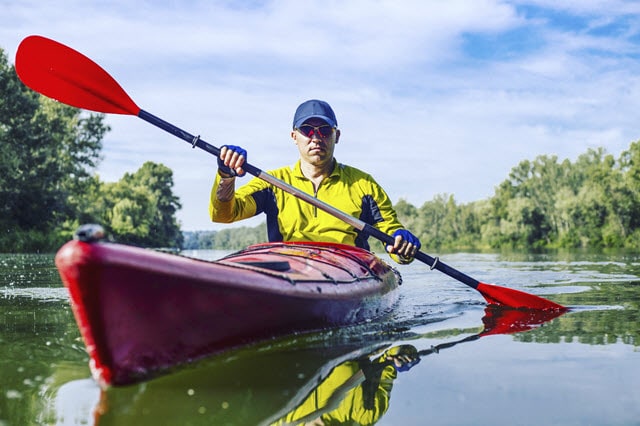
Find one that fits snugly but comfortably. Your life jacket must also come with a rescue whistle.
If you want, you can wear a buoyancy aid as an alternative to a life jacket. It looks similar but allows more movement around the arms and neck, which makes it popular among paddlers.
Refrain from wearing items around your neck like necklaces or lanyards. They can get caught around your neck if your kayak tips over, creating a dangerous situation.
Safety First!
Now let’s talk about kayak safety. Understanding how to stay safe in your kayak is the most important bit of knowledge when getting started with this popular watersport.
Get the Right Gear
You need the right safety gear and equipment.
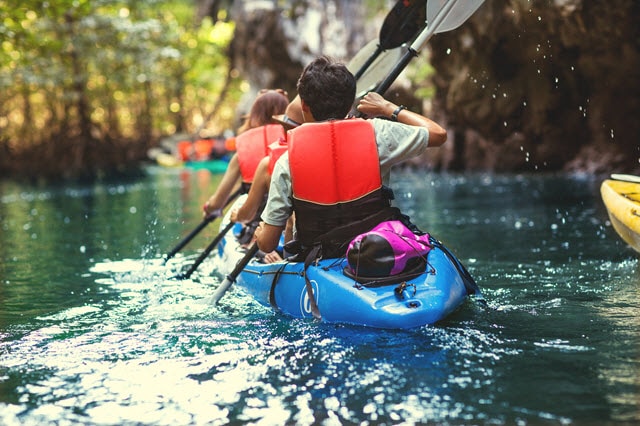
The safety gear you carry will depend on the type of trip you are going to take. You may not need to bring as many accessories if you’re only going out for a couple of hours or if you are going to kayak in calm river waters or near the shore.
One essential no matter how long your trip, though, is a PFD (personal flotation device), such as a life jacket. Wearing a life jacket is the law in many states, and it’s common sense for everyone.
Use your common sense and remember the old adage: better safe than sorry!
Set aside a decent budget for these accessories and don’t settle for cheap ones. That could put your life at risk.
Essential Safety Equipment
PFD (Personal Flotation Device)
As I talked about before, you’ve got to wear a PFD (personal flotation device). Keep it on at all stages of your journey on the river.
Even if the water seems super calm, don’t take chances. Conditions can change in an instant.
Dry Bag
Bring a dry bag for storing valuables such as your sunglasses, sunscreen, wallet, phone, food, and change of clothes.
First Aid Kit
Always have a first-aid kit at hand. It should include items such as bandages, tweezers, rubber gloves, disinfectant, and bug spray.
Helmet
Wear a helmet to protect your head, in case the waves become too rough or choppy and there’s a chance your boat capsizes in a rocky area.
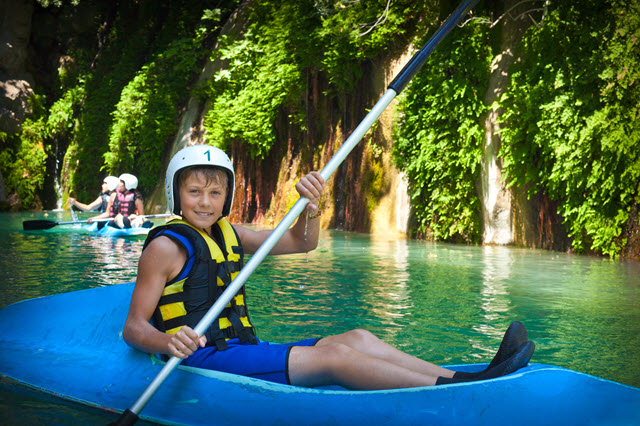
Waterproof GPS or a Map
Keep a waterproof GPS, as well as a map and compass in case your GPS loses battery.
Flashlight and Flares
Have a flashlight and flares, which will keep you visible if it gets dark or foggy. These are potentially life-saving items during emergencies.
Bilge Pump
Keep a bilge pump at hand in case water gets inside your boat. Your kayak may be at risk of sinking if you don’t.
Spray Deck or Skirt
Get a spray deck or skirt that covers your kayak’s cockpit, especially if you’re paddling through rapids.
Extra Paddle
Always, and I mean always, have an extra paddle in case your main paddle breaks or you lose grip and it falls into the water.
Can you even imagine being stranded on the water without a paddle? Don’t let that happen.
Be Prepared for Emergencies
How to act during emergencies is one of the most important things you need to know when you go paddling.
You are accountable for your safety.
Even if you have other experienced paddlers with you, they may struggle to save themselves in dangerous situations and may not have the opportunity to immediately assist you. Stay calm and alert as it will help you think clearly.
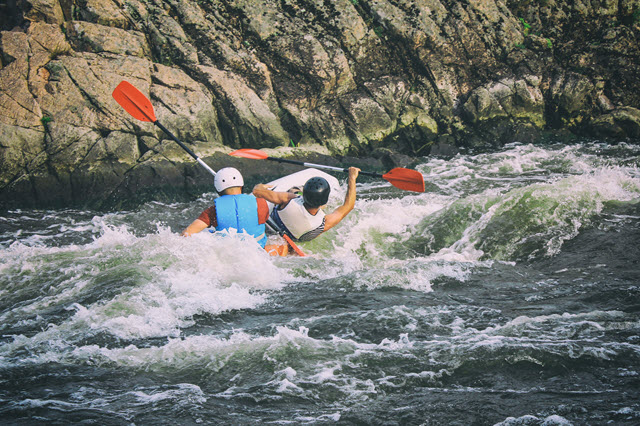
Remember all the survival and safety tips you have learned from your kayak lessons. This is also one of the reasons why attending kayak lessons will help a lot before you go on your first kayaking excursion.
You will go through a kayak capsize drill and learn how to put your boat back in an upright position to get in it again. Another thing that you need to remember is that people are more important than kayaks.
Keeping yourself and others safe and sound should come first. It doesn’t matter if your kayak drifts away or if you lose a paddle. You can always replace them.
Scout the Area for Hazards
Scout the area for possible obstacles before paddling. Verify that the rapids are within your skill level if you’re going on a whitewater kayak trip.
I have a complete article and guide about white water rapids classes, but here’s a summary in case you need something quick and easy.
Rapids vary in intensity and are classified into 6 categories.
The 6 Rapid Intensity Classifications
| Category | Description |
| Class I: Easy | Fast-moving water with a few riffles and small waves. There are few obstructions and you can usually spot them easily and well in advance. Slight risk to swimmers and paddlers. Self-rescue is easy. Ideal for beginner paddlers. |
| Class II: Moderate | Medium-quick rapids with regular waves. Clear and open passages between rocks and ledgers. Requires occasional maneuvering. Swimmers are seldom injured and group assistance is seldom required. Ideal for paddlers with intermediate skills. |
| Class III: Moderately Difficult | Rapids with moderate to high, irregular waves. Narrow passage requiring precise maneuvering present. Ideal for experienced or expert paddlers. |
| Class IV: Difficult | Long and powerful rapids with standing waves. Large holes and constricted passages are also present. Visual inspection is mandatory. Advance preparations for rescue operations are essential. |
| Class V: Extremely Difficult | Long, turbulent rapids follow one after another. Filled with obstructions, big drops, steep gradients, and strong currents. Rescue preparations and proper equipment are mandatory. Ideal for paddlers with extensive experience and advanced rescue skills. |
| Class VI: Extraordinarily Difficult | Runs are extremely difficult, dangerous, and rarely attempted. Paddlers may face life-threatening consequences if any error is made. Ideal for a team of experts, ensuring water levels are favorable through inspection. Take all the necessary precautions. |
Remember, the movement of rapids may change at any time. Yes, literally at any time. What does that mean?
Well, in effect, the river’s classification may change in intensity level while you’re already out on the water. I can’t emphasize this enough!
While that won’t occur very often, it’s important to check the rapids classification of the rivers you will navigate every time you plan a kayaking trip. In other words, just because you’ve already kayaked on a certain river doesn’t mean you automatically know what’s necessary to do so again.
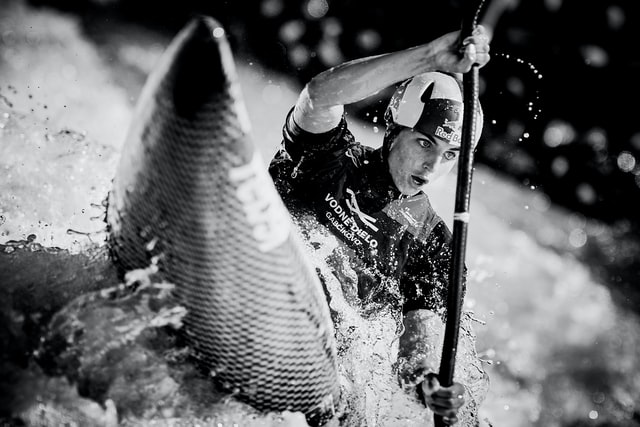
Let Someone Know About Your Trip
Before you go kayaking, let a friend or a family member know about your plans. Tell them who you are going with, where you are going, what time you are setting off, and when you’re expected to return from your trip.
Never Kayak Alone
Some people may prefer to enjoy nature and relax by themselves, but when you’re kayaking, it’s much safer to go with a kayak buddy or a group of paddlers. Not only is it more fun, but if there’s trouble or an accident, you’ll have someone to help you out.
Practice Proper Etiquette for Kayaking on Rivers
It’s like driving a car and following the rules of the road. You’ve got to follow correct kayaking etiquette when out on the river. I’ll go over them below.

Pass on the Right Side
If you see other paddlers, a jet ski, or a boat on the waterway, pass them on the right side.
Keep a Safe Distance
If you are paddling with a group, maintain a safe distance to the person paddling in front of you, and keep tabs on fellow paddlers. Give fishermen and motor boats a wide berth so they won’t feel uncomfortable.
Respect Wildlife
Be kind to nature and leave wildlife at peace in their natural habitat. Also, keep your trash neatly packed, instead of throwing them out in the water or at some remote place in the woods.
Final Thoughts About Kayaking on Rivers
Excited to get out on the water? River kayaking opens up a new world to explore, but remember all the risk and obstacles.
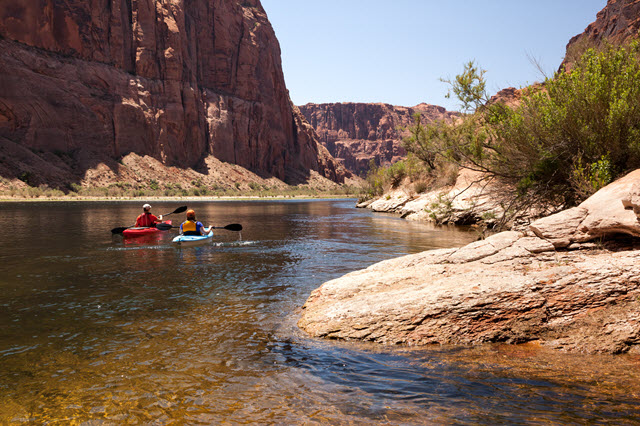
I believe I’ve given you a great start as you prepare to try your new hobby! Before you go on the water, make sure you:
- Take a paddling class
- Have the right kind of kayak and paddles
- Know the different kayak strokes
- Have all the right safety gear and clothing
- Know how to deal with emergencies
- Know the 6 rapid intensity classifications
- Tell someone about your trip
- Understand kayaking rules and etiquette
Ready to plan an adventure on the river? Make sure it’s just as safe as it is fun!
Now that you’ve learned about river kayaking, is sea kayaking on the agenda? Read my article about how sea kayaks compare to river kayaks.

